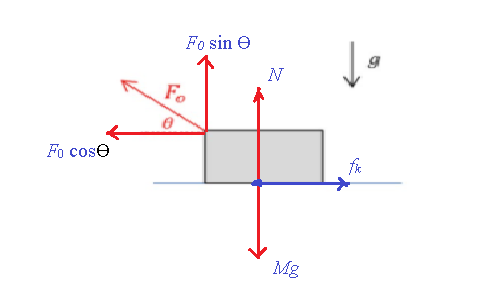A block of mass M is pulled along the floor by the force F, shown. The coefficient of kinetic friction is µx. and Hs respectively. What is the frictional force on the block? Don't guess! Use the free body diagram method. Fo O Hk ( Mg - Fo cos(e) ) O Hk (Mg + Fo) O Hk ( Mg + Fo cos(0) ) O Hk (Mg - Fo sin(e) ) Ο μ F sin (θ) O Hk Fo cos(e) O Hk ( Mg - Fo) Ο μμ ( Mg + , si (θ) )|
A block of mass M is pulled along the floor by the force F, shown. The coefficient of kinetic friction is µx. and Hs respectively. What is the frictional force on the block? Don't guess! Use the free body diagram method. Fo O Hk ( Mg - Fo cos(e) ) O Hk (Mg + Fo) O Hk ( Mg + Fo cos(0) ) O Hk (Mg - Fo sin(e) ) Ο μ F sin (θ) O Hk Fo cos(e) O Hk ( Mg - Fo) Ο μμ ( Mg + , si (θ) )|
Related questions
Question
100%
Help, 2 questions

Transcribed Image Text:A block of mass M is pulled along the floor by the force F, shown. The coefficient of kinetic friction is µy. and
Hs respectively. What is the frictional force on the block? Don't guess! Use the free body diagram method.
K Fo
O Hk ( Mg - Fo cos(0))
Ο μ ( Mg + 6)
O Hk (Mg + Fo cos(0) )
O Hk ( Mg - Fosin(e) )
Ο μ F, sin ()
O Hk Fo cos(e)
O Hk ( Mg - Fo)
O Hk ( Mg + Fo sin(0) )

Transcribed Image Text:Which statement are true about the static friction force between two surfaces? More than one statement
may be true, choose ALL true statements for full credit.
Here u, is the coefficient of static friction and FN is the normal force between two surfaces.
O The static friction force is exactly enough to prevent the two surfaces from sliding relative to each other.
O The static friction force is always equal to µ̟FN-
O There can be a static friction force between two moving objects as long as the two surfaces do not slide against each
other (for example, if both objects are moving at the same velocity.)
O The static friction force is always less than or equal to u,FN-
O The static friction force is always equal to µ̟Mg.
O Static friction cannot be used to accelerate objects (such as a car).
The static friction force is always equal to the weight of the object.
Expert Solution
Step 1
Hello. Since you have posted multiple questions and not specified which question needs to be solved, we will solve the first question for you. If you want any other specific question to be solved then please resubmit only that question or specify the question number.
Answer:
Consider the following free body diagram of the block.

Here, N is the normal reaction force acting on the block.
Here, we have resolved F0 into its components along the X and Y-axes.
Step by step
Solved in 2 steps with 3 images
